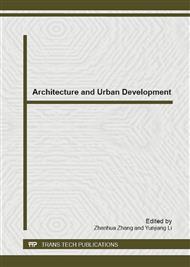p.366
p.370
p.374
p.379
p.384
p.388
p.393
p.400
p.404
Bearing Capacity Analysis of Masonry Wall Reinforced by Boards Wall Considering Stress-Lag Effect
Abstract:
This paper has primarily studied stress-lag effect for reinforced components by using the finite element method. The mature finite element analysis software ANSYS is selected as the calculation tool and the research object is a brick wall of reinforcing concrete splint. The concrete splints bear most horizontal seismic shear force for the stiffness of the new surface course is high. When seismic action occurs, the concrete splints may be broken before the brick walls. After compared the results of ANSYS and PKPM, the actual bearing capacity value of the concrete splints is smaller than the calculation results of the reinforcement design method by current codes for ignoring the influence of stress-lag effect.
Info:
Periodical:
Pages:
384-387
Citation:
Online since:
November 2012
Authors:
Price:
Сopyright:
© 2012 Trans Tech Publications Ltd. All Rights Reserved
Share:
Citation:


